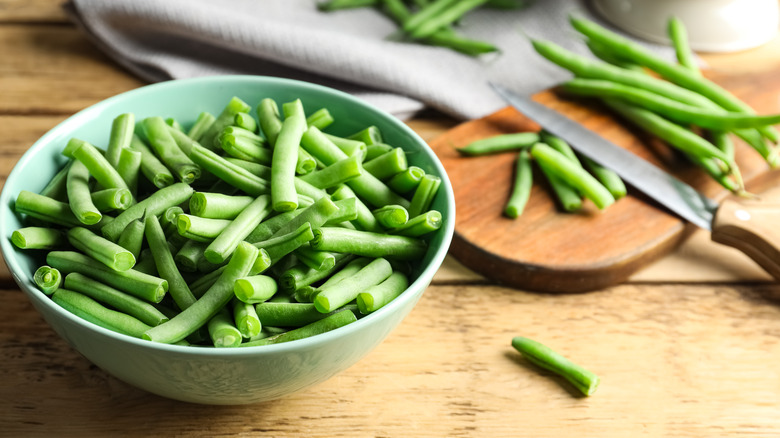The Simple Test To Tell Whether Or Not Your Green Beans Are Stringless
It used to be the case that stringing beans was as much of a thing as shucking corn. String beans were so-named because of the tough fibrous thread that ran down their vertical center — and while these strings are technically edible, they're about as appetizing as dental floss. So, home cooks (and conscripted family members) would sit on the porch, a colander of fresh string beans on one side and a basket at their feet, and de-string each bean. If you can't spare the extra prep time, use this simple test to determine if your beans are stringed instead: Pinch off the end of a whole bean and see if you can unzip the string down its seam. You know the answer right away.
If you're into buying and stringing some beans, this test gives you the basic knowledge of how it works. You'll need to cut off both ends of a whole bean before cooking it anyway, so using one of those ends to string the thing will simply be value-added. There's a deep satisfaction in stringing a bean: It tends to happen in one simple sweeping motion, puts up a pleasant (if slight) resistance, and gets rid of the vegetable's one unappealing quality. Now they're ready for the dill pickling treatment. But you'll have to look pretty hard to find string beans, and here's why.
How string beans became green beans
Because mankind tends to be a marvelous combination of resourceful and lazy, strings were bred out of commercial beans by the end of the 19th century. All credit is due to New York plant breeder C.N. Keeney for this thankless task. He's the one who snapped uncountable beans in half until he found a pair of genetic oddities whose beans didn't have strings. Keeney used these stringless individuals to breed a cultivar he ultimately marketed with the snappy name of Keeney's Stringless Refugee Wax — which doesn't exactly sound like food, but he made out okay.
Corporate canneries caught on, and farmers quickly started cultivating stringless beans for commercial production. What they were not quick to do, however, was serve the new stringless beans rather than their beloved (and far more tasty) heirloom string beans at the kitchen table. Just as we've seen with tomatoes commercially hybridized to have higher yields, thicker skins, and firmer flesh for ease of shipping, this kind of profitable tinkering usually comes at the cost of flavor and texture. So, now we have heirloom beans and tomatoes.
Artisinal beans
Heirloom string beans are still around, prized for their taste and texture. (Stringless beans compensate for their lack of a fiber by being all-round tougher.) They can be produced from tall, trellis-supported "pole" or shorter, bushy "runner" plants and come in various colors besides green: streaked, yellow, or even purple. Heirloom beans are native to South and Central America, with different varieties associated with their popular growing region: The Kentucky Wonder (formerly known as the Texas pole) is one example, as is the Purple Podded Pole, originally found in somebody's Ozark garden in the 1930s.
So, if you come across some heirloom string beans at your local farmer's market or grocery store, give 'em a try and see how different they are from the canned variety you probably first became familiar with. Once you've used the simple test to see if they've got a string, go home, give 'em a good rinse, and sit down with a colander full of pole beans on one side and a basket at your feet and get to work. You'll soon learn why the old timers used to say that "the string ties in the flavor." You'll also have the perfect reason to explore some upgraded green bean cooking strategies.


